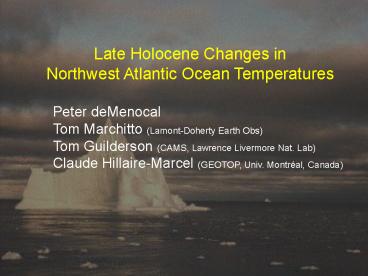Late Holocene Changes in - PowerPoint PPT Presentation
1 / 23
Title:
Late Holocene Changes in
Description:
Tom Marchitto (Lamont-Doherty Earth Obs) Tom Guilderson (CAMS, Lawrence Livermore Nat. ... Keigwin, 1996; Dahl-Jenssen et al., 1998; Lamb, 1995; Bianchi et al., 1999. ... – PowerPoint PPT presentation
Number of Views:113
Avg rating:3.0/5.0
Title: Late Holocene Changes in
1
Late Holocene Changes in Northwest Atlantic
Ocean Temperatures Peter deMenocal Tom Marchitto
(Lamont-Doherty Earth Obs) Tom Guilderson (CAMS,
Lawrence Livermore Nat. Lab) Claude
Hillaire-Marcel (GEOTOP, Univ. Montréal,
Canada)
2
Holocene 1-2 kyr cooling cycles
Century-scale cooling events Widespread 1-2
C amplitude Transitions within decades Deep
circulation responses Bond et al., 1997,
2001 deMenocal et al., 2000 Marchitto and
deMenocal, subm. Keigwin, 1996 Dahl-Jenssen et
al., 1998 Lamb, 1995 Bianchi et al., 1999.
3
N. Atlantic Holocene climate records
Surface cooling was widespread... synchronous
everywhere?
4
The Plan ...
- Measure Mg/Ca and d18O composition of N.
pachyderma (right) to monitor Late Holocene
changes in NW Atlantic SSTs. - Core site situated at southeastern edge of the
subpolar gyre - Well dated, detailed record
5
Talk Overview
- Part 1 Core locations, setting, and hydrography
- Part 2 Mg/Ca calibration and foram ecology
- Part 3 The records Did the NW Atlantic warm
during late Holocene cool events? - Part 4 Implications and Conclusions
6
Part 1 Orphan Knoll MC23, GGC024 (3530 m)
7
NW Atlantic Foram Productivity
- Spring and fall blooms
- Most of N. pachy. flux occurs in late Spring
(May-June) - Due to lengthening day, warming surface waters,
and nutrient availability.
8
Orphan Knoll Hydrography
N. pachyderma (right) records May-June conditions
9
Part 2 Mg/Ca vs. SST calibration
- NW Atlantic coretops
- Seven cores lt3500m
- 45-62N, 28-55W
- N. pachy (r) Mg/Ca consistent with annual avg.
SST - G. bulloides reflects calcification in warmer
seasonal waters, and/or heterog. shell Mg. - Consistent with Elderfield and Gansen (2000)
results.
10
Cores and Methods
- Orphan Knoll
- Multicore-gravity core pair MC-23/GGC24 (3530m)
- Bomb 14C coretop, 15 AMS radiocarbon dates (G.
bulloides) - 14 cm/ka sed. rate 20-80 year resolution
- Planktonic Mg/Ca - N. pachy. (right)
- 75 specimens, 150-212µm size, cleaned
- Analysis by ICP-AES
- 40 replicates 0.13 mmol/mol error
- Elderfield and Gansen (2000) temperature equation
11
Part 3 MC23 Mg/Ca and d18O
12
NW Atlantic SSTs warmed during Holocene cool
events
- NW Atlantic was consistently warmer during
Holocene lithic events. - Warming was 3-5C
- Negative NAO-like signature (i.e cool NE
Atlantic N. Europe, warm Labrador Sea)
13
Implications for Surface Water property changes
- Modern Surface Waters
- SST 7.5C
- Salinity 34.5 psu
- Little Ice Age Surface Waters
- SST 12C
- Salinity 35.7 psu (calcd from Mg/Ca and d18O)
- LIA properties similar to modern N. Atlantic
Drift water
14
Is this really a record of surface conditions?
- Changes in seasonality?
- No evidence for isotopic shifts between
bulloides, N. pachy (r,l) (Hillaire-Marcel,
deVernal, Sandrine data).
15
Is this really a record of surface conditions?
- Changes in seasonality?
- No evidence for isotopic shifts between
bulloides, N. pachy (r,l) (Sandrine,
Hillaire-Marcel, deVernal, unpub). - Dissolution?
- No apparent correlation between shell weight
Mg/Ca.
16
Is this really a record of surface conditions?
- Changes in seasonality?
- No evidence for isotopic shifts between
bulloides, N. pachy (r,l) (Sandrine,
Hillaire-Marcel, deVernal, unpub). - Dissolution?
- No apparent correlation between shell weight
Mg/Ca. - Changes in salinity?
- No. (Nürnberg et al., 1996)
17
Part 4 Annular-Mode pattern for Holocene events?
18
Solar Variability Century-scale pulsing of
Solar luminosity
Holocene event pacing linked to changes in solar
irradiance (Bond et al., 2001)
19
NAO variability during the latest Holocene
- Persistent negative NAO during Late Maunder
Minimum (AD 1650-1710) - Cook et al., 2002 (Europe, N. America)
- Luterbacher et al., 2001 (Europe)
- Appenzeller et al., 1998 (Greenland)
- Mann et al., 1998 (Circum - North Atlantic)
- Nesje et al., 2002 (antiphase European glaciers)
20
Correlation Map Surface Temps vs. Solar
irradiance (AD 1650-1850)
Shindell et al., 2001
21
Modeled surface temperature changesduring the
Maunder Minimum (ca. 1680 AD)
Persistent negative NAO pattern
Annual Temperature change (C Shindell et al.,
2002)
22
Summary
23
Age Control
- 15 AMS 14C dates to 9.5 ka BP (G. bulloides)
- Bomb 14C coretop
- 14 cm/ka average sed. rate.
- 1.2-2.4 yr BP Low sed. rate interval (6 cm/ka)































